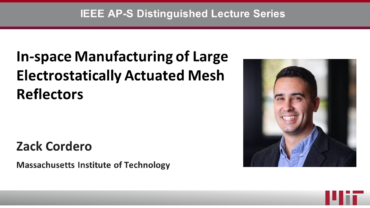Seminar Co-Sponsored with AP-S

Large reflectors in space (>30 m diameter) can enable advances in communications, remote sensing, and astronomy, by enabling antennas with increased gain, resolution, and bandwidth. However, modern deployable reflectors exhibit a decrease in performance as their diameter increases, due to fabrication errors, slewing, and disturbances on orbit, such as thermal distortion, which decrease surface precision. A potential solution to achieve larger apertures with high precision is to combine in-space manufacturing (ISM) with active control. Herein we demonstrate a reflector concept which combines a candidate ISM process called Bend-Forming with electrostatic actuation to achieve closed-loop control of the reflector surface. We design and fabricate a 1-meter diameter prototype of an electrostatically actuated X-band reflector, using a knitted gold-molybdenum mesh as the reflector surface, carbon fiber-reinforced plastic booms as electrodes, and a truss support structure fabricated with Bend-Forming (a deformation process for constructing trusses from wire feedstock). To characterize the performance of this prototype, we measure its radiation patterns at X-band in an RF anechoic chamber. We successfully demonstrate 1) the stabilization of a pull-in instability with closed-loop control, and 2) beam steering of up to 4.2 degrees with asymmetric electrostatic actuation. Our reflector prototype highlights the opportunities of implementing electrostatically-actuated reflector antennas in space.
